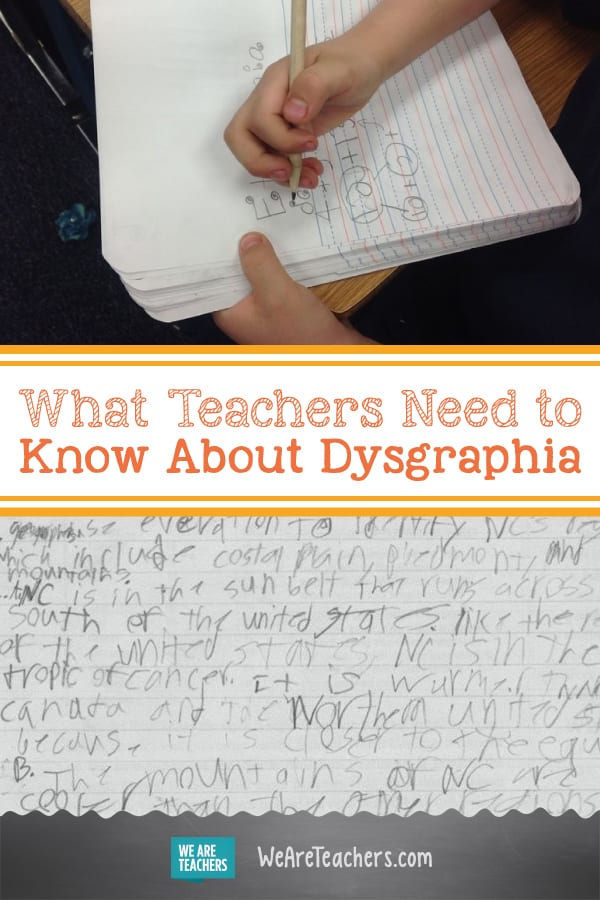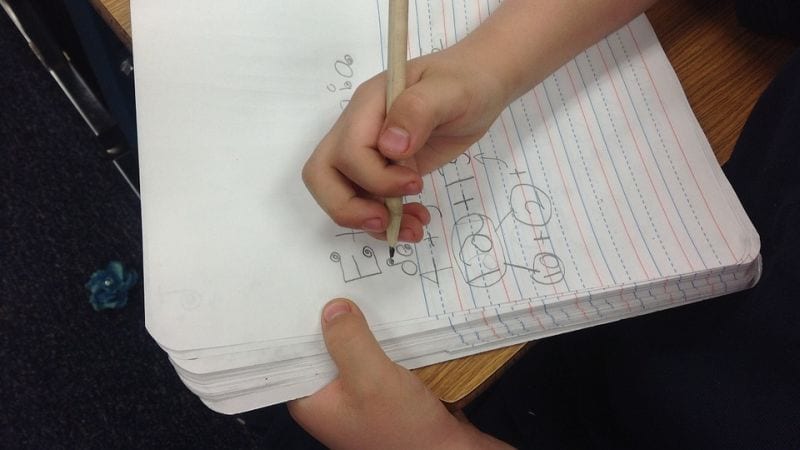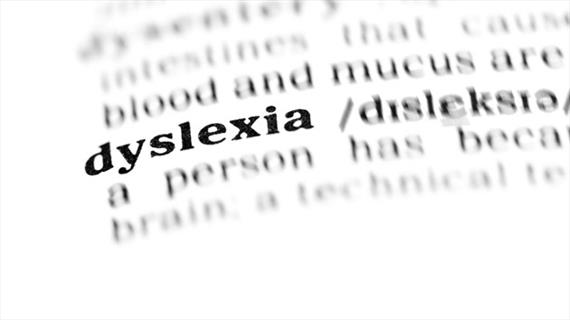David’s second grade teacher, Ms. Lee, is at her wit’s end. David is a bright student and loves to participate in class. But when it comes to written assignments, Ms. Lee can’t make heads or tails of what he turns in. His words run together, the letters are different sizes, and his sentences trail off in the middle. His spelling tests are atrocious, even though he can often spell the words correctly out loud in class. All of this is starting to affect his grades—and his self-esteem. It’s not until Ms. Lee mentions her concerns to the school’s intervention specialist that she learns that David’s struggles might have a name: dysgraphia.
What is dysgraphia?
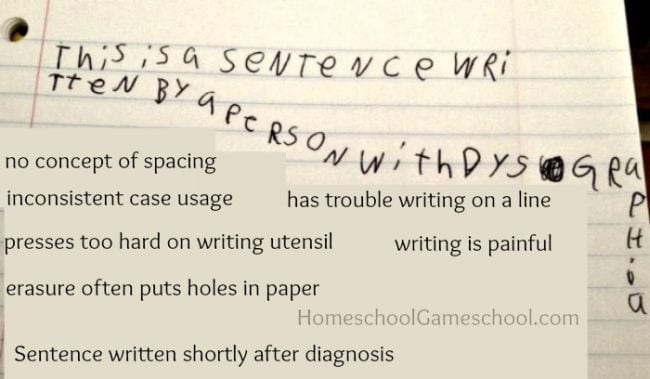
Source: Homeschool Gameschool
Dysgraphia is a learning disorder that affects writing, both the physical act and composition. It’s often referred to as “an impairment in written expression” by psychologists. This condition affects both thinking and motor skills, leading a student to struggle to put their thoughts into words on paper. Since many school assignments involve writing in one form or another, dysgraphia can cause problems across the curriculum. It’s estimated to occur in some form in four to 20 percent of the population.
Imagine you’ve assigned a short essay question on a test, like “Explain the major causes of the American Civil War.” Most people begin by thinking about what they’ve learned about the topic, accessing their memory for relevant facts. Then, they organize those facts and consider what they want to say. Finally, they pick up their pen or pencil and start writing.
A student with dysgraphia faces multiple challenges here. First, they may have trouble organizing their thoughts on the subject, even if they know it well. Then, when it’s time to start writing, their poor motor skills make it even more difficult to get their thoughts down on the test paper. In the end, they’re left with a poorly spelled, nearly illegible response to the question—one that most likely doesn’t reflect their actual knowledge and ability.
Learn how to recognize dysgraphia signs.
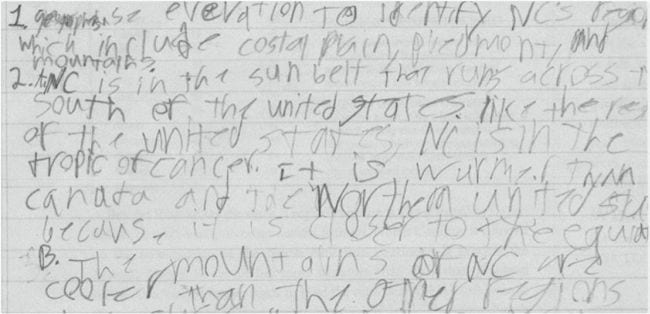
Source: Dyslexic Advantage
Learning to write is a skill that takes lots of practice for nearly everyone. So how can you tell if your student is struggling because they just need more practice or because of a more serious problem, like dysgraphia? Here are some signs and symptoms to look for at each age. Get a more complete list here.
Note: Dysgraphia and dyslexia can have similar symptoms, and it’s not uncommon for a child to have both. Learn more here.
Pre-K
Even before they start to write, kids with dysgraphia may display some signs. Problems with fine motor skills may make them hold a crayon awkwardly or have trouble tracing or connecting the dots. They rarely choose activities like coloring books, because holding a crayon is uncomfortable for them. Learn more about the ways pre-K students are affected.
Elementary School
This is the most obvious time for dysgraphia to make itself known. You’ll notice a student holding their pencil awkwardly and continuing to do so no matter how many times you correct it. Handwriting is usually not just messy, but illegible—so bad that students often can’t even read their own handwriting later. The student struggles with correct spacing and letter size and often uses capitals and lower-case letters interchangeably. Spelling is a major issue, regardless of repetition and practice. Learn more about the ways elementary students are affected.
Middle and High School
Students with dysgraphia avoid and procrastinate written work at all costs. Though they may be able to express their thoughts extremely well out loud, they stare at a blank page for hours, making no progress. When they do write, their thoughts, and even their words, are often incomplete. Taking notes in class is very difficult, and what they do manage to get down is often useless later on. Even math class may present issues, since writing long equations and lining up numbers and symbols can be a challenge. Learn more about the ways middle school and high school students are affected.
Other Dysgraphia Challenges
Because dysgraphia is related to fine motor skills, kids with this condition might have trouble doing things like tying their shoes or using scissors. Their inability to organize their thoughts means they have problems making lists or often lose their train of thought when talking. On a social-emotional level, these kids might feel “lazy” or “dumb,” though that’s far from the truth.
Support students with dysgraphia.
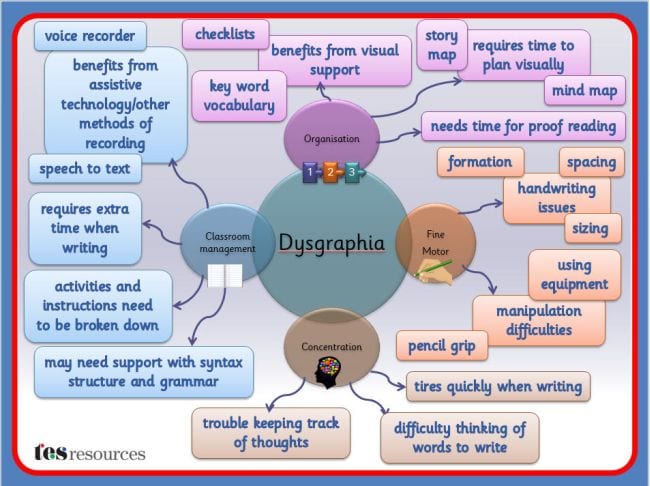
Download a free printable version of this poster from here.
Think you have a student with dysgraphia? First, just as you would with any learning disorder, work to have them evaluated so a proper plan, like an IEP, can be put in place. Writing is such a key skill that early intervention is the best way to give kids a chance to succeed. A specialist can help determine the right accommodations for your student, but here are some general strategies to try.
- Think outside the pencil box. Learning to write is incredibly hard for kids with dysgraphia. You’ll likely need to employ some creative methods if you’re teaching K–2, when handwriting is most important. Experiment with different writing utensils and types of paper (graph paper can be especially helpful) and encourage extra practice at home. Studies have shown that with effort and practice, handwriting can improve dramatically, though it may never be easy for these kids. Find more useful strategies here.
- Make writing count. Because students with dysgraphia often know the information but have trouble putting it in writing, consider whether a written assignment is really the best way to assess their knowledge. When possible, allow them to complete tasks orally. Provide typed copies of notes in advance or allow them to use a recording device during lectures.
- Give extra time. As with many learning disorders, sometimes kids just need some extra time. Allow them to begin early, finish late, or even take work home to complete it at a pace that’s comfortable for them.
- Be flexible on spelling and grammar. Again, always be sure you’re truly assessing the knowledge you’re asking the student to demonstrate. If spelling or grammar isn’t particularly important for the assignment, don’t mark the student down for those errors.
- Teach good composition skills. This is one where everyone in the class can benefit. Make sure you’re helping all students learn how to properly plan and execute a writing assignment, whether short or long. These skills are especially challenging to those with dysgraphia, so make sure those steps are very clear for them before they begin. Learn how to run a writing workshop here.
What about typing?
While typing written assignments instead of handwriting them can help students whose writing is illegible, keyboard skills also require fine motor control. And as we’ve said before, dysgraphia goes beyond messy handwriting. So while typing can be a great accommodation for some kids, it isn’t a miracle solution. Also, everyone should strive for basic writing skills so they can fill out forms at the doctor or jot down a reminder on a sticky note from time to time.
Get dysgraphia resources.
Teachers can best help students with dysgraphia succeed when they know more about the topic. Here are some good places to start.
Online:
- Understanding Dysgraphia, Understood.com
- LD Online – Writing and Spelling Disorders
- ADDitude – What Is Dysgraphia?
Books:
(WeAreTeachers receives a small percentage of purchases you make through these affiliate links.)
- Source for Dyslexia and Dysgraphia (Richards, 2004)
- Teaching Students with Dyslexia, Dysgraphia, OWL LD, and Dyscalculia (Berninger/Wolf 2015)
Do you have questions about helping students with dysgraphia? Come ask other teachers in our WeAreTeachers HELPLINE Facebook group.
Plus, what teachers need to know about dyscalculia and dyslexia.
